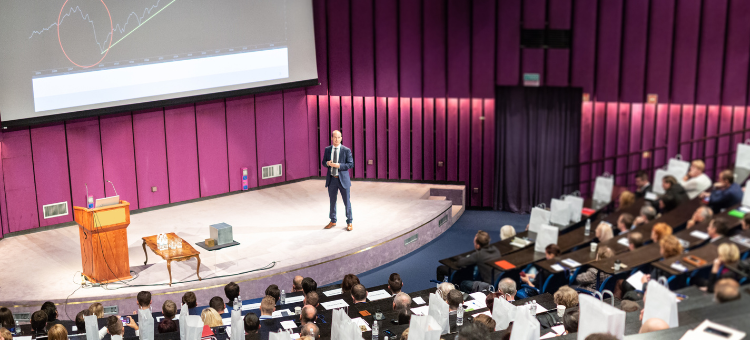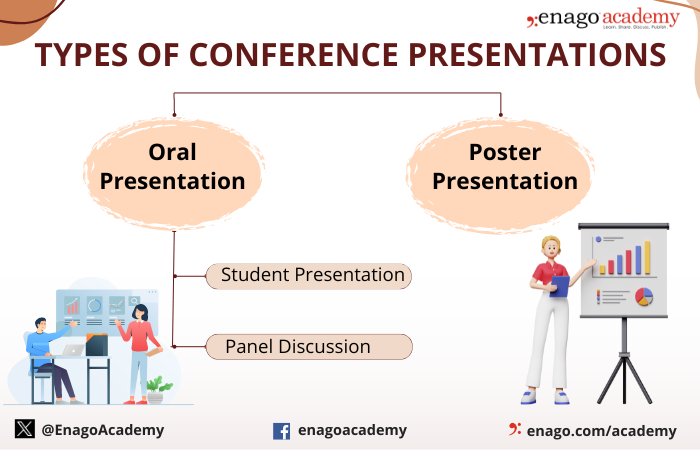Beyond the Podium: Understanding the differences in conference and academic presentations

Conferences can be captivating as it where knowledge meets presentation skills. They serve as dynamic platforms where scholars, researchers, and professionals interact to share insights, exchange ideas, and foster collaboration. The importance of conferences lies in their ability to nurture intellectual growth, stimulate discussions, and propel academic advancements. Let’s uncover the intricacies of various conference presentations to help you shine in the academic spotlight.
The Multi-faceted Nature of Conference
Conference is a broad term that encompasses various professional/ academic events. As we delve deeper into such events, we encounter different types of conferences, each serving a specific purpose. Common types of conferences include Business Conferences, Academic Conferences, Educational Conferences, Scientific Conferences, Social/ Cultural Conferences, Peace Conferences, Trade Conferences, Press or News Conferences, and Authors’ Conferences.
In addition to the different types of conferences, there are several types of conference presentations. Understanding them is important to make the right presentation for a conference before submitting your abstract.
Types of Conference Presentations
Here are the commonly used formats for conference presentations:
 1. Oral Presentation
1. Oral Presentation
Oral presentations are the standard form of presentation where the speaker(s) share details about their research questions, methodology, findings, applications, etc. It lasts between 15-30 minutes. Oral presentations can be further divided into four subtypes:
1.1. Student Presentation:
These presentations emphasize on students work and offer them an opportunity to share their work with the academic community.
1.2. Panel Discussion:
Panel discussions are delivered by a panel of speakers who share different aspects of the presentations. Furthermore, such events are generally more open and characterized by engaging discussions.
2. Poster Presentation
Poster presentations are less formal platforms to share your work in a visual format. Presenters summarize their work in a visually appealing poster and display them for the attendees to understand.
Both oral and poster presentations serve as integral components of conferences, catering to different learning preferences and promoting the exchange of knowledge among researchers and professionals in diverse fields.
However, based on the difference in the content, and the intended audience, conference presentations can be divided as:
1. Academic Presentations
Academic presentations at conferences are the bedrock of knowledge dissemination. They showcase research findings, theories, and contribute to the collective intellectual discourse.
- General Elements: Title and Authorship, Introduction, Objectives/ Hypothesis, Methodology, Results, Discussion, Conclusion, and Recommendations
- Who Presents: Researchers, Scholars, Academics, Graduate Students, and Professionals
- For Whom: Peers, Fellow Researchers, Scholars, Academics, Professionals, Reviewers, and Critics
2. Research Presentations
Research presentations delve into the specifics of a study, highlighting methodologies, results, and implications. Additionally, they bridge the gap between theory and practical application, offering a comprehensive view of the research process.
- General Elements: Title Slide, Introduction, Objectives/ Hypothesis, Literature Review, Research Design and Methodology, Results, Discussion, Conclusion, and Recommendations
- Who Presents: Researchers or Scholars who conducted the study, Primary Author(s), Principal Investigator, Graduate Students, and Collaborators
- For Whom: Peers and Colleagues, Academic Community, Reviewers and Assessors, Industry Professionals, Policy Makers and Practitioners, and Funding Agencies
3. Grant Proposal Presentations
These presentations aim to convince funding bodies about the significance and viability of a proposed project. However, they require a blend of persuasive communication and a clear articulation of the project’s objectives and potential impact.
- General Elements: Introduction, Background and Rationale, Objectives and Goals, Methods and Approach, Timeline, Budget, Evaluation and Metrics, Sustainability and Long-term Impact, Collaborations and Partnerships, Team Qualifications and Expertise, Plan of Action, and Challenges and Mitigation Strategies
- Who Presents: Principal Investigator, Co-Investigators or Collaborators, Project Team Members, Institutional Representatives, Community or Stakeholder Representatives, and Advisors or Mentors (for Students)
- For Whom: Granting Organization Representatives, Review Committee or Panel, Advisory Board, Potential Collaborators or Partners, Community Stakeholders, Internal Team or Collaborators, and Public or Lay Audience (Rarely)
4. Thesis Presentations
Thesis presentations mark the culmination of academic endeavors. They involve presenting the key findings and contributions of a research project undertaken for a degree, providing an opportunity for peers and experts to evaluate the work.
- General Elements: Title Slide, Author’s Name and Affiliation, Date of the Presentation, Introduction, Background and Context, Research Objectives and Hypotheses, Methodology, Results, Discussion, Contribution to the Field, Limitations, Conclusion, Recommendations for Future Research, and References
- Who Presents: Thesis Candidate (Student), Thesis Committee, and Thesis Advisor (Supervisor)
- For Whom: Instructors and Evaluators, Peers and Classmates, Academic Community, and Reviewers
Understanding different types of presentations in conferences can empower researchers to make appropriate presentations that meets the requirement of the conference. However, to make your presentations more interactive, here is a downloadable guide with specific tips for conference presentations.
Making each presentation type distinct involves tailoring your approach based on the purpose, audience, and format of the presentation. To maximize your conference experience, consider participating in interactive sessions and networking with the other participants. Engage with your peers, ask questions, and embrace the collaborative spirit that conferences embody.
The diverse array of conference presentations creates a vibrant tapestry of knowledge sharing. Each format offers a unique avenue for researchers and professionals to showcase their work and connect with a broader audience. So, whether you find yourself behind a podium or beside a poster board, remember that the power of conferences lies in the collective exchange of ideas, where each presenter and attendee contributes to the saga of knowledge and discovery.
Frequently Asked Questions
Creating a successful conference presentation involves careful planning, organization, and effective communication. Here are steps to guide you through the process:
1. Understand Your Audience
2. Define Your Objectives
3. Understand the conference type
4. Create a Clear Structure
5. Craft Engaging Content
6. Practice Time Management
7. Prepare for Q&A
An academic presentation is a formal communication of research findings, scholarly work, or educational content delivered to an audience within an academic or professional setting. These presentations occur in various formats, such as lectures, seminars, workshops, or conference sessions, and they serve the purpose of sharing knowledge, insights, and research outcomes with peers, students, or other members of the academic community. Academic presentations can cover a wide range of topics, including research methodologies, experimental results, literature reviews, theoretical frameworks, and educational practices.
A conference presentation is a formal communication delivered at a conference, seminar, symposium, or similar academic or professional gathering. These presentations serve as a means for researchers, scholars, professionals, and experts to share their work, findings, and insights with a wider audience. Conference presentations cover a diverse range of topics, including research studies, case analyses, theoretical frameworks, and practical applications within various fields. They play a crucial role in the advancement of academic and professional fields by facilitating the exchange of ideas, fostering collaboration, and showcasing the latest research and developments in a given area of study.










Learning is a process and does not end. You keep on wanting to know more. I have learnt a lot .